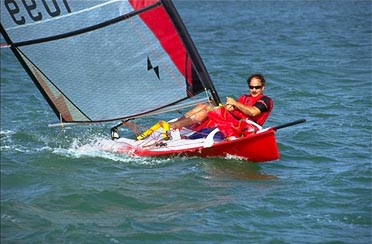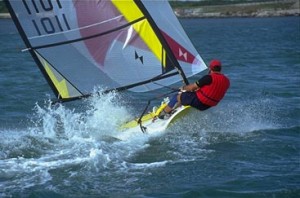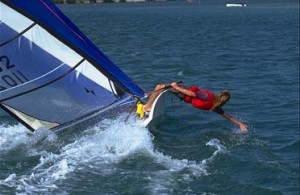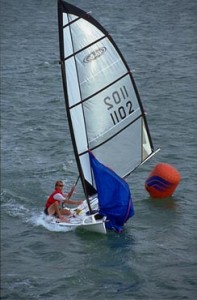MX-Ray
MX-Ray: Single hander from Russian-born Naval Architect
 Setting up the mast and sail of the MX-Ray follows windsurfing practice in a number of important details. The mast itself is very similar to modern carbon windsurfing tubes and is made in two pieces by Fibrespar, using the same equipment. The monofilm sleeve luff sail from North fits over the mast with the added complication of camber inducers on the upper two battens. As might be expected the tension in these two battens is especially important to the final look of the rig and it cannot be easily be adjusted once the mast is up. The spinnaker halyard feeds through a cut-out in the luff sleeve and it is important to make sure everything is lined up. With the sail in place the rig can be dropped in the mast tube and the boom attached.
Setting up the mast and sail of the MX-Ray follows windsurfing practice in a number of important details. The mast itself is very similar to modern carbon windsurfing tubes and is made in two pieces by Fibrespar, using the same equipment. The monofilm sleeve luff sail from North fits over the mast with the added complication of camber inducers on the upper two battens. As might be expected the tension in these two battens is especially important to the final look of the rig and it cannot be easily be adjusted once the mast is up. The spinnaker halyard feeds through a cut-out in the luff sleeve and it is important to make sure everything is lined up. With the sail in place the rig can be dropped in the mast tube and the boom attached. Leaving the beach is easy enough with the rudder swinging down and the centerboard dropping easily through the slot. Those used to more conventional dinghies will find that it's all too easy to sit too far forward. The center of buoyancy in this boat is set well aft and its important to keep the weight in precisely the right place in order to establish the proper trim. To the conventional dinghy sailor the rig looks unusual with a substantially pre-bent mast and lots of luff curve, again very much in windsurfer style.
Leaving the beach is easy enough with the rudder swinging down and the centerboard dropping easily through the slot. Those used to more conventional dinghies will find that it's all too easy to sit too far forward. The center of buoyancy in this boat is set well aft and its important to keep the weight in precisely the right place in order to establish the proper trim. To the conventional dinghy sailor the rig looks unusual with a substantially pre-bent mast and lots of luff curve, again very much in windsurfer style.
In practice the rig proves to be more like a windsurfer than a dinghy with the top of the mast bending off in the gust significantly, opening the upper leach and de-powering the rig. All the drive remains in the bottom of the sail and it's important to work with this to get the best out of the boat upwind. In fact, getting the MX-Ray going upwind requires much more than just sheeting in and hiking out. A really physical performance from the helmsman with sheet adjustments, body movements and rudder is required in fairly large measure to get the boat moving through the waves. There's no doubt that the very fine entry and full stern make the boat sensitive to both heel and fore; the very soft rig (by dinghy standards) needs plenty of physical input to keep it working at its best. The good news is that the hiking position on the rounded side decks is good, though with very limited adjustment of the single toe strap possible, it wouldn't pay to be too big or too small. Minimal freeboard does ensure a wet ride. The non-slip hits a good compromise between grip and aggressiveness.
A really physical performance from the helmsman with sheet adjustments, body movements and rudder is required in fairly large measure to get the boat moving through the waves. There's no doubt that the very fine entry and full stern make the boat sensitive to both heel and fore; the very soft rig (by dinghy standards) needs plenty of physical input to keep it working at its best. The good news is that the hiking position on the rounded side decks is good, though with very limited adjustment of the single toe strap possible, it wouldn't pay to be too big or too small. Minimal freeboard does ensure a wet ride. The non-slip hits a good compromise between grip and aggressiveness.
In terms of the work required to get the best out of the MX-Ray, things don't change much when you turn to go downwind. In ordinary circumstances, hoisting the spinnaker proves reasonably easy. The combined halyard and tack-line system features a reverse one-to-three, requiring a pull of just over a meter to get the sail all the way up. Though this can make for a fast hoist, the loads are also significantly increased and the whole thing does need a fairly substantial pull to get it aloft. More significantly, if the spinnaker has filled with water for any reason (and it did several times during our test), it proves all but impossible to pull up using the halyard. The best solution seemed to be either to squeeze the water out of the kite by hand or, if it's not too windy, pull the kite out of the chute manually and then hoist it up. The key to rapid progress downwind seems to be to cleat the main and work the boat through the waves using a combination of body weight, steering and spinnaker sheet. Performance is very much in the skiff class with the apparent wind coming forward very rapidly as the kite fills. In a race situation picking the angles will inevitably be critical to a good result.
The key to rapid progress downwind seems to be to cleat the main and work the boat through the waves using a combination of body weight, steering and spinnaker sheet. Performance is very much in the skiff class with the apparent wind coming forward very rapidly as the kite fills. In a race situation picking the angles will inevitably be critical to a good result.
Once mastered — and it took a while — gybing is no harder than in a Laser. Off wind balance is an issue and it's important not only to get in the right place fore and aft, but to keep the body movements going to help with the steering. As with upwind this is not really a boat to be steered with the rudder alone and good coordination between the two sheets, rudder and helm position really are required to get the best out of the boat. Getting the kite down is no harder than getting it up though there does seem to be a lot of downhaul to pull in.
Construction is conventional GRP with a foam sandwich deck. Although the hull lacks any subdivision, there are two separate buoyancy bags contained within to keep it all afloat in the event of serious damage. There is no wear ring on either the mast or mast tube and abrasion on either component will lead to replacement of the entire part. Fittings, though few, are well-situated and everything seemed to work.
Though requirements ensure that all new boats now come with some kind of instruction manual, few are as comprehensive or as well-laid-out as the one that comes with the MX-Ray. In addition to all the usual details on how to rig the boat — including the length and diameter of every rope — and even how to sail it to good effect, there is a good section on emergency procedures that provides some good advice on what to do in the event of all kinds of disasters including broken masts, lost rudders, etc.
While the MX-Ray undoubtedly provides a great big shot of adrenalin while reaching along, upwind performance is decidedly pedestrian and it is difficult to get the best out of the boat. Its certainly unusual and as with all new products that break an existing mold it will not be for everyone. Those looking for a one-man skiff should certainly take a look.
X-Ray is now built and marketed by FastBoatWorks under License Agreement with M-Yachts.
FastBoatWorks
9060 Palisade Ave.
N.Bergen, NJ ?07047
1-877-99-MX-RAY
www.mx-ray.com












